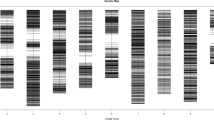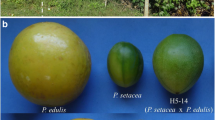Abstract
The annual habit in beet is due to complete or partial absence of the vernalization requirement and can cause severe problems in the beet crop. The absolute vernalization requirement in beet is controlled by a major geneB (bolting), known to be linked to the geneR (red hypocotyl color), in linkage group I. Segregation for theB andR genes was studied in several beet progenies. Penetrance of the annual habit inBb genotypes was affected by both environmental and genetic factors. The precise location in linkage group I of the major geneB was found by restriction fragment length polymorphism (RFLP) analysis in a back-cross progeny exhibiting partial penetrance of the annual habit. The linkage value betweenB andR was in good accordance with previous estimations. Use of the closest RFLP marker (pKP591: 3.8 recombination units) allowed us to estimate the penetrance of the annual habit in this back-cross as 0.62. Evidence of pseudo-compatibility was found in the wild coastal beet (Beta vulgaris sspmaritima) used as the mother plant of the back-cross: the selfing rate was estimated as 7%.
Similar content being viewed by others
References
Abe J, Yoshikawa H, Tsuda C (1987) Reproductive barriers in sugar beets and its relatives of the sectionvulgares, the genusBeta. J Fac Agr Hokkaido Univ 63:40–48
Abegg FA (1936) A genetic factor for the annual habit in beets and linkage relationship. J Agric Res 53:493–511
Barocka KH (1985) Zucker- und Futterrüben. In: Hoffmann W, Mudra A, Plarre W (eds), Lehrbuch der Züchtung landwirtschaftlicher Kulturpflanzen, Bd. 2 Spezieller Teil. Verlag Paul Parey, Berlin Hamburg, pp 245–287
Barzen E, Mechelke W, Ritter E, Seitzer JF, Salamini F (1992) RFLP markers for sugar beet breeding — chromosomal linkage maps and location of major genes for Rhizomania resistance, monogermy and hypocotyl color. Plant J 2:601–611
Beavis WD, Grant D (1991) A linkage map based on information from four F2 populations of maize (Zea mays L.). Theor Appl Genet 82:636–644
Bolelova ZA, Tikhonova VG, Leshchenko EV (1984) Genetical and physiological aspects of bolting in sugar beet plants. Sel'sk Khoz Biologiya 10:90–95
Boudry P, Mörchen M, Saumitou-Laprade P, Vernet Ph, Van Dijk H (1993) The origin and evolution of weed beets: consequences for the breeding and release of herbicide-resistant transgenic sugar beets. Theor Appl Genet 87:471–478
Curtis GJ (1964) Graft transmission of the flowering stimulus from a wildBeta species to a line of beet selected for resistance to bolting. Nature 202:1238–1964
Dale MFB, Ford-Lloyd BV (1983) Reproductive characters associated with breeding behaviour inBeta sect.Beta (Chenopodiaceae). Pl Syst Evol 143:277–283
Desprez M (1980) Observations et remarques sur la montée à graine chez la betterave sucrière. CR Acad Agric Fr: 44–53
Evans A, Weir J (1981) The evolution of weed beet in sugar beet crops. Kulturpflanzen 24:301–310
Fatmi A, Poneleit CG, Pfeffer TW (1993) Variability of recombination frequencies in Iowa Stiff Stalk Synthetic (Zea mays L.). Theor Appl Genet 86:859–866
Feinberg AP, Vogelstein B (1983) A technique for radiolabeling DNA restriction endonuclease fragments to high specific activity. Anal Biochem 137:266–267
Gebhardt C, Ritter E, Barone A, Debener T, Walkemeir B, Schachtschabel U, Kaufmann H, Thompson RD, Bonierbale MW, Ganal MW, Tanksley SD, Salamini F (1991) RFLP maps of potato and their alignment with the homoeologous tomato genome. Theor Appl Genet 83:49–57
Knapp E (1958) Beta-Rüben Bes. Zuckerrüben. In: Kappert H, Rudorf W (eds), Handbuch der Pflanzenzüchtung, vol 2. Verlag Paul Parey, Berlin Hamburg, pp 196–284
Kosambi DD (1944) The estimation of map distances from recombination values. Ann Eugen 12:172–175
Lander ES, Green P, Abrahamson I, Barlow A, Daly MJ, Lincoln SE, Newburg L (1987) MAPMAKER: An interactive computer package for constructing primary genetic linkage maps of experimental and natural populations. Genomics 1:174–181
Le Cochec F, Soreau P (1989) Mode d'action des gènes et hétérosis pour le caractère montée à graines dans le croisement de deux lignées fixées de betteraves à sucre (Beta vulgaris L.). Agronomie 9:585–590
Letschert JPW (1993)Beta sectionBeta: biogeographical patterns of variation and taxonomy. Thesis, Wageningen Agricultural University Papers 93-1
Lexander K (1980) Present knowledge of sugar beet bolting mechanism. 43rd Winter Congr, Inst Int Rech Betterav, Bruxelles, pp 245–258
Longden P, Goddard V (1987) Effects of weed beet on crop yield and processabililty. Br Sugar Beet Rev 55:10–11
Marcus WB (1948) Inheritance of bolting resistance. Proc Am Soc Sugar Beet Technol 5:154–155
Margara J (1960) Recherches sur le déterminisme de l'élongation et de la floraison dans le genre Beta. Ann Amélior Plant 10:361–471
Munerati O (1931) L'eredità della tendenza alla annualità nella commune barbabietola coltivata. Ztschr Züchtung, Reihe A, Pflanzenzüchtung 17:84–89
Nelson RT, Deming GW (1952) Effect of bolters on yield and sucrose content of sugar beet. Proc Am Soc Sugar Beet Technol 6:441–444
Owen FV (1942) Inheritance of cross- and self-sterility and self-fertility inBeta vulgaris. J Agric Res 64:679–698
Owen FV (1954) The significance of single gene reactions in sugar beets. Proc Am Soc Sugar Beet Technol 8:392–398
Owen FV, Ryser GK (1942) Some Mendelian characters inBeta vulgaris and linkages observed in the Y-R-B group. J Agric Res 65:155–698171
Pharis RP, King RW (1985) Gibberellins and reproductive development in seed plants. Annu Rev Plant Physiol 36:517–568
Pillen K, Steinrücken G, Wricke G, Herrmann RG, Jung C (1992). A linkage map of sugar beet (Beta vulgaris L.). Theor Appl Genet 84:129–135
Pocock TP, Lenton JR (1980) Potential use of retardants for chemical control of bolting in sugar beet. In: Recent developments in the use of plant growth reterdants. Clifford DR, Lenton JR (eds) Br Plant Growth Regul Group Monogr 4:41–52
Rimpau W (1876) Das Aufschiessen der Runkelrüben. Landw Jahrb 5:31–45
Ritter E, Debener T, Barone A, Salamini F, Gebhart C (1991) RFLP mapping on potato chromosomes of two controlling genes extreme resistance to potato virus X (PVX). Mol Gen Genet 227:81–85
Saumitou-Laprade P, Rouwendal GJA, Cuguen J, Krens FFA, Michaelis G (1993) Different CMS sources found inBeta vulgaris ssp. maritima: mitochondrial variability in wild populations revealed by a rapid screening procedure. Theor Appl Genet 85: 529–535
Smed E, Van Geyt JPC, Oleo M (1989) Genetical control and linkage relationships of isozyme markers in sugar beet (B. vulgaris L.). Theor Appl Genet 78:97–104
Stout M (1945) Translocation of the reproductive stimulus in sugar beets. Bot Gaz 107:86–95
Tanksley SD, Young ND, Paterson AH, Bonierbale MW (1989) RFLP mapping in plant breeding — new tools for an old science. Bio/Technol 7:257–264
Theurer JC (1968) Linkage tests of Mendelian male sterility and the other genetic characters in sugarbeets,Beta vulgaris L. Crop Sci 8:698–701
Van Dijk H, Boudry P (1992) Genetic variability for life-histories inBeta maritima. In: Frese L (ed) InternationalBeta Genetic Resources Network. A report on the 2nd IntBeta Genetic Resources Workshop held at the Institute for Crop Science and Plant Breeding, Braunschweig, Germany, 24–28 June 1991. Int Crop Network Series No. 7. Int Board for Plant Genetic Resources, Rome:4–16
Van Geyt JPC, Oleo M, Lange W, De Bock TSM (1988) Monosomic additions in beet (Beta vulgaris) carrying extra chromosomes ofBeta procumbens. Theor Appl Genet 76:577–586
Vince-Prue D (1975) Photoperiodism in plants. Mcgraw-Hill Book Compagny, London
Wang ML, Atkinson MD, Cinoy CN, Devos KM, Harcourt RL, Liu CJ, Rogers WJ, Gale MD (1991) RFLP-based genetic map of rye (Secalel cereale L.) chromosome1R. Theor Appl Genet 82:174–178
Wood DW, Scoot RK (1975) Sowing sugar beet in autumn in England. J Agric Sci 84:97–108
Author information
Authors and Affiliations
Additional information
Communicated by R. Hagemann
Rights and permissions
About this article
Cite this article
Boudry, P., Wieber, R., Saumitou-Laprade, P. et al. Identification of RFLP markers closely linked to the bolting gene B and their significance for the study of the annual habit in beets (Beta vulgaris L.). Theoret. Appl. Genetics 88, 852–858 (1994). https://doi.org/10.1007/BF01253996
Received:
Accepted:
Issue Date:
DOI: https://doi.org/10.1007/BF01253996




